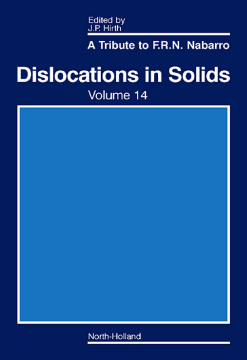
Additional Information
Book Details
Abstract
New models for dislocation structure and motion are presented for nanocrystals, nucleation at grain boundaries, shocked crystals, interphase interfaces, quasicrystals, complex structures with non-planar dislocation cores, and colloidal crystals. A review of experimentally established main features of the magnetoplastic effect with their physical interpretation explains many diverse results of this type. The model has many potential applications for forming processes influenced by magnetic fields.
• Dislocation model for the magnetoplastic effect
• New mechanism for dislocation nucleation and motion in nanocrystals
• New models for the dislocation structure of interfaces between crystals with differing crystallographic structure
• A unified view of dislocations in quasicrystals, with a new model for dislocation motion
• A general model of dislocation behavior in crystals with non-planar dislocation cores
• Dislocation properties at high velocities
• Dislocations in colloidal crystals
